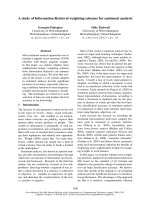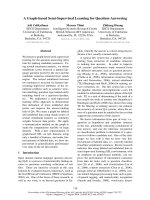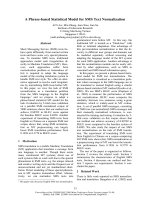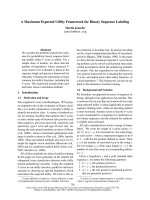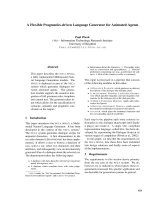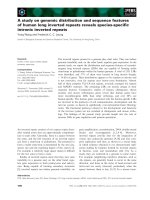Báo cáo khoa học: "A Study on Automatically Extracted Keywords in Text Categorization" doc
Bạn đang xem bản rút gọn của tài liệu. Xem và tải ngay bản đầy đủ của tài liệu tại đây (67.16 KB, 8 trang )
Proceedings of the 21st International Conference on Computational Linguistics and 44th Annual Meeting of the ACL, pages 537–544,
Sydney, July 2006.
c
2006 Association for Computational Linguistics
A Study on Automatically Extracted Keywords in Text Categorization
Anette Hulth and Be
´
ata B. Megyesi
Department of Linguistics and Philology
Uppsala University, Sweden
Abstract
This paper presents a study on if and how
automatically extracted keywords can be
used to improve text categorization. In
summary we show that a higher perfor-
mance — as measured by micro-averaged
F-measure on a standard text categoriza-
tion collection — is achieved when the
full-text representation is combined with
the automatically extracted keywords. The
combination is obtained by giving higher
weights to words in the full-texts that
are also extracted as keywords. We also
present results for experiments in which
the keywords are the only input to the cat-
egorizer, either represented as unigrams
or intact. Of these two experiments, the
unigrams have the best performance, al-
though neither performs as well as head-
lines only.
1 Introduction
Automatic text categorization is the task of assign-
ing any of a set of predefined categories to a doc-
ument. The prevailing approach is that of super-
vised machine learning, in which an algorithm is
trained on documents with known categories. Be-
fore any learning can take place, the documents
must be represented in a form that is understand-
able to the learning algorithm. A trained predic-
tion model is subsequently applied to previously
unseen documents, to assign the categories. In
order to perform a text categorization task, there
are two major decisions to make: how to repre-
sent the text, and what learning algorithm to use
to create the prediction model. The decision about
the representation is in turn divided into two sub-
questions: what features to select as input and
which type of value to assign to these features.
In most studies, the best performing representa-
tion consists of the full length text, keeping the
tokens in the document separate, that is as uni-
grams. In recent years, however, a number of ex-
periments have been performed in which richer
representations have been evaluated. For exam-
ple, Caropreso et al. (2001) compare unigrams
and bigrams; Moschitti et al. (2004) add com-
plex nominals to their bag-of-words representa-
tion, while Kotcz et al. (2001), and Mihalcea and
Hassan (2005) present experiments where auto-
matically extracted sentences constitute the input
to the representation. Of these three examples,
only the sentence extraction seems to have had any
positive impact on the performance of the auto-
matic text categorization.
In this paper, we present experiments in which
keywords, that have been automatically extracted,
are used as input to the learning, both on their own
and in combination with a full-text representation.
That the keywords are extracted means that the se-
lected terms are present verbatim in the document.
A keyword may consist of one or several tokens.
In addition, a keyword may well be a whole ex-
pression or phrase, such as snakes and ladders.
The main goal of the study presented in this pa-
per is to investigate if automatically extracted key-
words can improve automatic text categorization.
We investigate what impact keywords have on the
task by predicting text categories on the basis of
keywords only, and by combining full-text repre-
sentations with automatically extracted keywords.
We also experiment with different ways of rep-
resenting keywords, either as unigrams or intact.
In addition, we investigate the effect of using the
headlines — represented as unigrams — as input,
537
to compare their performance to that of the key-
words.
The outline of the paper is as follows: in Section
2, we present the algorithm used to automatically
extract the keywords. In Section 3, we present the
corpus, the learning algorithm, and the experimen-
tal setup for the performed text categorization ex-
periments. In Section 4, the results are described.
An overview of related studies is given in Section
5, and Section 6 concludes the paper.
2 Selecting the Keywords
This section describes the method that was used to
extract the keywords for the text categorization ex-
periments discussed in this paper. One reason why
this method, developed by Hulth (2003; 2004),
was chosen is because it is tuned for short texts
(more specifically for scientific journal abstracts).
It was thus suitable for the corpus used in the de-
scribed text categorization experiments.
The approach taken to the automatic keyword
extraction is that of supervised machine learning,
and the prediction models were trained on man-
ually annotated data. No new training was done
on the text categorization documents, but models
trained on other data were used. As a first step
to extract keywords from a document, candidate
terms are selected from the document in three dif-
ferent manners. One term selection approach is
statistically oriented. This approach extracts all
uni-, bi-, and trigrams from a document. The two
other approaches are of a more linguistic charac-
ter, utilizing the words’ parts-of-speech (PoS), that
is, the word class assigned to a word. One ap-
proach extracts all noun phrase (NP) chunks, and
the other all terms matching any of a set of empir-
ically defined PoS patterns (frequently occurring
patterns of manual keywords). All candidate terms
are stemmed.
Four features are calculated for each candi-
date term: term frequency; inverse document fre-
quency; relative position of the first occurrence;
and the PoS tag or tags assigned to the candidate
term. To make the final selection of keywords,
the three predictions models are combined. Terms
that are subsumed by another keyword selected
for the document are removed. For each selected
stem, the most frequently occurring unstemmed
form in the document is presented as a keyword.
Each document is assigned at the most twelve key-
words, provided that the added regression value
Assign. Corr.
mean mean P R F
8.6 3.6 41.5 46.9 44.0
Table 1: The number of assigned (Assign.) key-
words in mean per document; the number of cor-
rect (Corr.) keywords in mean per document; pre-
cision (P); recall (R); and F-measure (F), when 3–
12 keywords are extracted per document.
(given by the prediction models) is higher than an
empirically defined threshold value. To avoid that
a document gets no keywords, at least three key-
words are assigned although the added regression
value is below the threshold (provided that there
are at least three candidate terms).
In Hulth (2004) an evaluation on 500 abstracts
in English is presented. For the evaluation, key-
words assigned to the test documents by profes-
sional indexers are used as a gold standard, that
is, the manual keywords are treated as the one
and only truth. The evaluation measures are preci-
sion (how many of the automatically assigned key-
words that are also manually assigned keywords)
and recall (how many of the manually assigned
keywords that are found by the automatic indexer).
The third measure used for the evaluations is the
F-measure (the harmonic mean of precision and
recall). Table 1 shows the result on that particu-
lar test set. This result may be considered to be
state-of-the-art.
3 Text Categorization Experiments
This section describes in detail the four experi-
mental settings for the text categorization exper-
iments.
3.1 Corpus
For the text categorization experiments we used
the Reuters-21578 corpus, which contains 20 000
newswire articles in English with multiple cate-
gories (Lewis, 1997). More specifically, we used
the ModApte split, containing 9 603 documents for
training and 3 299 documents in the fixed test set,
and the 90 categories that are present in both train-
ing and test sets.
As a first pre-processing step, we extracted the
texts contained in the TITLE and BODY tags. The
pre-processed documents were then given as in-
put to the keyword extraction algorithm. In Ta-
ble 2, the number of keywords assigned to the doc-
538
uments in the training set and the test set are dis-
played. As can be seen in this table, three is the
number of keywords that is most often extracted.
In the training data set, 9 549 documents are as-
signed keywords, while 54 are empty, as they have
no text in the TITLE or BODY tags. Of the 3 299
documents in the test set, 3 285 are assigned key-
words, and the remaining fourteen are those that
are empty. The empty documents are included in
the result calculations for the fixed test set, in or-
der to enable comparisons with other experiments.
The mean number of keyword extracted per docu-
ment in the training set is 6.4 and in the test set 6.1
(not counting the empty documents).
Keywords
Training docs Test docs
0 54 14
1
68 36
2
829 272
3
2 016 838
4
868 328
5
813 259
6
770 252
7
640 184
8
527 184
9
486 177
10
688 206
11
975 310
12
869 239
Table 2: Number of automatically extracted key-
words per document in training set and test set re-
spectively.
3.2 Learning Method
The focus of the experiments described in this pa-
per was the text representation. For this reason, we
used only one learning algorithm, namely an im-
plementation of Linear Support Vector Machines
(Joachims, 1999). This is the learning method that
has obtained the best results in text categorization
experiments (Dumais et al., 1998; Yang and Liu,
1999).
3.3 Representations
This section describes in detail the input repre-
sentations that we experimented with. An impor-
tant step for the feature selection is the dimen-
sionality reduction, that is reducing the number
of features. This can be done by removing words
that are rare (that occur in too few documents or
have too low term frequency), or very common
(by applying a stop-word list). Also, terms may
be stemmed, meaning that they are merged into a
common form. In addition, any of a number of
feature selection metrics may be applied to further
reduce the space, for example chi-square, or infor-
mation gain (see for example Forman (2003) for a
survey).
Once that the features have been set, the final
decision to make is what feature value to assign.
There are to this end three common possibilities:
a boolean representation (that is, the term exists in
the document or not), term frequency, or tf*idf.
Two sets of experiments were run in which the
automatically extracted keywords were the only
input to the representation. In the first set, key-
words that contained several tokens were kept in-
tact. For example a keyword such as paradise fruit
was represented as paradise
fruit and was
— from the point of view of the classifier — just as
distinct from the single token fruit as from meat-
packers. No stemming was performed in this set
of experiments.
In the second set of keywords-only experiments,
the keywords were split up into unigrams, and also
stemmed. For this purpose, we used Porter’s stem-
mer (Porter, 1980). Thereafter the experiments
were performed identically for the two keyword
representations.
In a third set of experiments, we extracted only
the content in the TITLE tags, that is, the head-
lines. The tokens in the headlines were stemmed
and represented as unigrams. The main motiva-
tion for the title experiments was to compare their
performance to that of the keywords.
For all of these three feature inputs, we first
evaluated which one of the three possible feature
values to use (boolean, tf, or tf*idf). Thereafter,
we reduced the space by varying the minimum
number of occurrences in the training data, for a
feature to be kept.
The starting point for the fourth set of exper-
iments was a full-text representation, where all
stemmed unigrams occurring three or more times
in the training data were selected, with the feature
value tf*idf. Assuming that extracted keywords
convey information about a document’s gist, the
feature values in the full-text representation were
given higher weights if the feature was identical to
a keyword token. This was achieved by adding the
term frequency of a full-text unigram to the term
539
frequency of an identical keyword unigram. Note
that this does not mean that the term frequency
value was necessarily doubled, as a keyword often
contains more than one token, and it was the term
frequency of the whole keyword that was added.
3.4 Training and Validation
This section describes the parameter tuning, for
which we used the training data set. This set
was divided into five equally sized folds, to de-
cide which setting of the following two parameters
that resulted in the best performing classifier: what
feature value to use, and the threshold for the min-
imum number of occurrence in the training data
(in this particular order).
To obtain a baseline, we made a full-text uni-
gram run with boolean as well as with tf*idf fea-
ture values, setting the occurrence threshold to
three.
As stated previously, in this study, we were
concerned only with the representation, and more
specifically with the feature input. As we did not
tune any other parameters than the two mentioned
above, the results can be expected to be lower than
the state-of-the art, even for the full-text run with
unigrams.
The number of input features for the full-text
unigram representation for the whole training set
was 10 676, after stemming and removing all to-
kens that contained only digits, as well as those
tokens that occurred less than three times. The
total number of keywords assigned to the 9 603
documents in the training data was 61 034. Of
these were 29 393 unique. When splitting up the
keywords into unigrams, the number of unique
stemmed tokens was 11 273.
3.5 Test
As a last step, we tested the best performing rep-
resentations in the four different experimental set-
tings on the independent test set.
The number of input features for the full-text
unigram representation was 10 676. The total
number of features for the intact keyword repre-
sentation was 4 450 with the occurrence thresh-
old set to three, while the number of stemmed
keyword unigrams was 6 478, with an occurrence
threshold of two. The total number of keywords
extracted from the 3 299 documents in the test set
was 19 904.
Next, we present the results for the validation
and test procedures.
4 Results
To evaluate the performance, we used precision,
recall, and micro-averaged F-measure, and we let
the F-measure be decisive. The results for the 5-
fold cross validation runs are shown in Table 3,
where the values given are the average of the five
runs made for each experiment. As can be seen
in this table, the full-text run with a boolean fea-
ture value gave 92.3% precision, 69.4% recall, and
79.2% F-measure. The full-text run with tf*idf
gave a better result as it yielded 92.9% precision,
71.3% recall, and 80.7% F-measure. Therefore we
defined the latter as baseline.
In the first type of the experiment where each
keyword was treated as a feature independently
of the number of tokens contained, the recall
rates were considerably lower (between 32.0%
and 42.3%) and the precision rates were somewhat
lower (between 85.8% and 90.5%) compared to
the baseline. The best performance was obtained
when using a boolean feature value, and setting the
minimum number of occurrence in training data to
three (giving an F-measure of 56.9%).
In the second type of experiments, where
the keywords were split up into unigrams and
stemmed, recall was higher but still low (between
60.2% and 64.8%) and precision was somewhat
lower (88.9–90.2%) when compared to the base-
line. The best results were achieved with a boolean
representation (similar to the first experiment) and
the minimum number of occurrence in the training
data set to two (giving an F-measure of 75.0%)
In the third type of experiments, where only the
text in the TITLE tags was used and was repre-
sented as unigrams and stemmed, precision rates
increased above the baseline to 93.3–94.5%. Here,
the best representation was tf*idf with a token oc-
curring at least four times in the training data (with
an F-measure of 79.9%).
In the fourth and last set of experiments, we
gave higher weights to full-text tokens if the same
token was present in an automatically extracted
keyword. Here we obtained the best results. In
these experiments, the term frequency of a key-
word unigram was added to the term frequency
for the full-text features, whenever the stems were
identical. For this representation, we experi-
mented with setting the minimum number of oc-
currence in training data both before and after that
the term frequency for the keyword token was
added to the term frequency of the unigram. The
540
Input feature Feature value Min. occurrence Precision Recall F-measure
full-text unigram bool 3 92.31 69.40 79.22
full-text unigram
tf*idf 3 92.89 71.30 80.67
keywords-only intact bool 1 90.54 36.64 52.16
keywords-only intact
tf 1 88.68 33.74 48.86
keywords-only intact
tf*idf 1 89.41 32.05 47.18
keywords-only intact bool 2 89.27 40.43 55.64
keywords-only intact
bool 3 87.11 42.28 56.90
keywords-only intact
bool 4 85.81 41.97 56.35
keywords-only unigram bool 1 89.12 64.61 74.91
keywords-only unigram
tf 1 89.89 60.23 72.13
keywords-only unigram
tf*idf 1 90.17 60.36 72.31
keywords-only unigram bool 2 89.02 64.83 75.02
keywords-only unigram
bool 3 88.90 64.82 74.97
title bool 1 94.17 68.17 79.08
title
tf 1 94.37 67.89 78.96
title
tf*idf 1 94.46 68.49 79.40
title tf*idf 2 93.92 69.19 79.67
title
tf*idf 3 93.75 69.65 79.91
title
tf*idf 4 93.60 69.74 79.92
title
tf*idf 5 93.31 69.40 79.59
keywords+full tf*idf 3 (before adding) 92.73 72.02 81.07
keywords+full
tf*idf 3 (after adding) 92.75 71.94 81.02
Table 3: The average results from 5-fold cross validations for the baseline candidates and the four types
of experiments, with various parameter settings.
highest recall (72.0%) and F-measure (81.1%) for
all validation runs were achieved when the occur-
rence threshold was set before the addition of the
keywords.
Next, the results on the fixed test data set for
the four experimental settings with the best per-
formance on the validation runs are presented.
Table 4 shows the results obtained on the fixed
test data set for the baseline and for those experi-
ments that obtained the highest F-measure for each
one of the four experiment types.
We can see that the baseline — where the full-
text is represented as unigrams with tf*idf as fea-
ture value — yields 93.0% precision, 71.7% re-
call, and 81.0% F-measure. When the intact key-
words are used as feature input with a boolean fea-
ture value and at least three occurrences in train-
ing data, the performance decreases greatly both
considering the correctness of predicted categories
and the number of categories that are found.
When the keywords are represented as uni-
grams, a better performance is achieved than when
they are kept intact. This is in line with the find-
ings on n-grams by Caropreso et al. (2001). How-
ever, the results are still not satisfactory since both
the precision and recall rates are lower than the
baseline.
Titles, on the other hand, represented as uni-
grams and stemmed, are shown to be a useful in-
formation source when it comes to correctly pre-
dicting the text categories. Here, we achieve the
highest precision rate of 94.2% although the recall
rate and the F-measure are lower than the baseline.
Full-texts combined with keywords result in the
highest recall value, 72.9%, as well as the highest
F-measure, 81.7%, both above the baseline.
Our results clearly show that automatically ex-
tracted keywords can be a valuable supplement to
full-text representations and that the combination
of them yields the best performance, measured as
both recall and micro-averaged F-measure. Our
experiments also show that it is possible to do a
satisfactory categorization having only keywords,
given that we treat them as unigrams. Lastly, for
higher precision in text classification, we can use
the stemmed tokens in the headlines as features
541
Input feature Feature value Min. occurrence Precision Recall F-measure
full-text unigram tf*idf 3 93.03 71.69 80.98
keywords-only intact bool 3 89.56 41.48 56.70
keywords-only unigram
bool 2 90.23 64.16 74.99
title
tf*idf 4 94.23 68.43 79.28
keywords+full
tf*idf 3 92.89 72.94 81.72
Table 4: Results on the fixed test set.
with tf*idf values.
As discussed in Section 2 and also presented in
Table 2, the number of keywords assigned per doc-
ument varies from zero to twelve. In Figure 1, we
have plotted how the precision, the recall, and the
F-measure for the test set vary with the number of
assigned keywords for the keywords-only unigram
representation.
100
90
80
70
60
50
40
30
12(239)11(310)10(206)9(177)8(184)7(184)6(252)5(259)4(328)3(838)2(272)1(36)
Per cent
Number of assigned keywords (number of documents)
Precision
F-measure
Recall
Figure 1: Precision, recall, and F-measure for
each number of assigned keywords. The values
in brackets denote the number of documents.
We can see that the F-measure and the recall reach
their highest points when three keywords are ex-
tracted. The highest precision (100%) is obtained
when the classification is performed on a single
extracted keyword, but then there are only 36 doc-
uments present in this group, and the recall is low.
Further experiments are needed in order to estab-
lish the optimal number of keywords to extract.
5 Related Work
For the work presented in this paper, there are two
aspects that are of interest in previous work. These
are in how the alternative input features (that is, al-
ternative from unigrams) are selected and in how
this alternative representation is used in combina-
tion with a bag-of-words representation (if it is).
An early work on linguistic phrases is done by
F¨urnkranz et al. (1998), where all noun phrases
matching any of a number of syntactic heuristics
are used as features. This approach leads to a
higher precision at the low recall end, when eval-
uated on a corpus of Web pages. Aizawa (2001)
extracts PoS-tagged compounds, matching pre-
defined PoS patterns. The representation contains
both the compounds and their constituents, and
a small improvement is shown in the results on
Reuters-21578. Moschitti and Basili (2004) add
complex nominals as input features to their bag-
of-words representation. The phrases are extracted
by a system for terminology extraction
1
. The more
complex representation leads to a small decrease
on the Reuters corpus. In these studies, it is un-
clear how many phrases that are extracted and
added to the representations.
Li et al. (2003) map documents (e-mail mes-
sages) that are to be classified into a vector space
of keywords with associated probabilities. The
mapping is based on a training phase requiring
both texts and their corresponding summaries.
Another approach to combine different repre-
sentations is taken by Sahlgren and C¨oster (2004),
where the full-text representation is combined
with a concept-based representation by selecting
one or the other for each category. They show
that concept-based representations can outperform
traditional word-based representations, and that a
combination of the two different types of represen-
tations improves the performance of the classifier
over all categories.
Keywords assigned to a particular text can be
seen as a dense summary of the same. Some
reports on how automatic summarization can be
used to improve text categorization exist. For ex-
1
In terminology extraction all terms describing a domain
are to be extracted. The aim of automatic keyword indexing,
on the other hand, is to find a small set of terms that describes
a specific document, independently of the domain it belongs
to. Thus, the set of terms must be limited to contain only the
most salient ones.
542
ample, Ko et al. (2004) use methods from text
summarization to find the sentences containing the
important words. The words in these sentences are
then given a higher weight in the feature vectors,
by modifying the term frequency value with the
sentence’s score. The F-measure increases from
85.8 to 86.3 on the Newsgroups data set using Sup-
port vector machines.
Mihalcea and Hassan (2004) use an unsuper-
vised method
2
to extract summaries, which in turn
are used to categorize the documents. In their ex-
periments on a sub-set of Reuters-21578 (among
others), Mihalcea and Hassan show that the preci-
sion is increased when using the summaries rather
than the full length documents.
¨
Ozg¨ur et al. (2005)
have shown that limiting the representation to
2 000 features leads to a better performance, as
evaluated on Reuters-21578. There is thus evi-
dence that using only a sub-set of a document can
give a more accurate classification. The question,
though, is which sub-set to use.
In summary, the work presented in this paper
has the most resemblance with the work by Ko et
al. (2004), who also use a more dense version of
a document to alter the feature values of a bag-of-
words representation of a full-length document.
6 Concluding Remarks
In the experiments described in this paper, we
investigated if automatically extracted keywords
can improve automatic text categorization. More
specifically, we investigated what impact key-
words have on the task of text categorization by
making predictions on the basis of keywords only,
represented either as unigrams or intact, and by
combining the full-text representation with auto-
matically extracted keywords. The combination
was obtained by giving higher weights to words in
the full-texts that were also extracted as keywords.
Throughout the study, we were concerned with
the data representation and feature selection pro-
cedure. We investigated what feature value should
be used (boolean, tf, or tf*idf) and the minimum
number of occurrence of the tokens in the training
data.
We showed that keywords can improve the per-
formance of the text categorization. When key-
words were used as a complement to the full-text
representation an F-measure of 81.7% was ob-
2
This method has also been used to extract keywords (Mi-
halcea and Tarau, 2004).
tained, higher than without the keywords (81.0%).
Our results also clearly indicate that keywords
alone can be used for the text categorization task
when treated as unigrams, obtaining an F-measure
of 75.0%. Lastly, for higher precision (94.2%) in
text classification, we can use the stemmed tokens
in the headlines.
The results presented in this study are lower
than the state-of-the-art, even for the full-text run
with unigrams, as we did not tune any other pa-
rameters than the feature values (boolean, term
frequency, or tf*idf) and the threshold for the min-
imum number of occurrence in the training data.
There are, of course, possibilities for further
improvements. One possibility could be to com-
bine the tokens in the headlines and keywords in
the same way as the full-text representation was
combined with the keywords. Another possible
improvement concerns the automatic keyword ex-
traction process. The keywords are presented in
order of their estimated “keywordness”, based on
the added regression value given by the three pre-
diction models. This means that one alternative
experiment would be to give different weights de-
pending on which rank the keyword has achieved
from the keyword extraction system. Another al-
ternative would be to use the actual regression
value.
We would like to emphasize that the automati-
cally extracted keywords used in our experiments
are not statistical phrases, such as bigrams or tri-
grams, but meaningful phrases selected by includ-
ing linguistic analysis in the extraction procedure.
One insight that we can get from these ex-
periments is that the automatically extracted key-
words, which themselves have an F-measure of
44.0, can yield an F-measure of 75.0 in the cat-
egorization task. One reason for this is that the
keywords have been evaluated using manually as-
signed keywords as the gold standard, meaning
that paraphrasing and synonyms are severely pun-
ished. Kotcz et al. (2001) propose to use text cate-
gorization as a way to more objectively judge au-
tomatic text summarization techniques, by com-
paring how well an automatic summary fares on
the task compared to other automatic summaries
(that is, as an extrinsic evaluation method). The
same would be valuable for automatic keyword in-
dexing. Also, such an approach would facilitate
comparisons between different systems, as com-
mon test-beds are lacking.
543
In this study, we showed that automatic text
categorization can benefit from automatically ex-
tracted keywords, although the bag-of-words rep-
resentation is competitive with the best perfor-
mance. Automatic keyword extraction as well as
automatic text categorization are research areas
where further improvements are needed in order to
be useful for more efficient information retrieval.
Acknowledgments
The authors are grateful to the anonymous review-
ers for their valuable suggestions on how to im-
prove the paper.
References
Akiko Aizawa. 2001. Linguistic techniques to im-
prove the performance of automatic text categoriza-
tion. In Proceedings of NLPRS-01, 6th Natural
Language Processing Pacific Rim Symposium, pages
307–314.
Maria Fernanda Caropreso, Stan Matwin, and Fabrizio
Sebastiani. 2001. A learner-independent evaluation
of the usefulness of statistical phrases for automated
text categorization. In Text Databases and Docu-
ment Management: Theory and Practice, pages 78–
102.
Susan Dumais, John Platt, David Heckerman, and
Mehran Sahami. 1998. Inductive learning algo-
rithms and representations for text categorization.
In Proceedings of the Seventh International Confer-
ence on Information and Knowledge Management
(CIKM’98), pages 148–155.
George Forman. 2003. An extensive empirical study
of feature selection metrics for text classification.
Journal of Machine Learning Research, 3:1289–
1305, March.
Johannes F¨urnkranz, Tom Mitchell, and Ellen Riloff.
1998. A case study using linguistic phrases for text
categorization on the WWW. In AAAI-98 Workshop
on Learning for Text Categorization.
Anette Hulth. 2003. Improved automatic keyword ex-
traction given more linguistic knowledge. In Pro-
ceedings of the Conference on Empirical Methods
in Natural Language Processing (EMNLP 2003),
pages 216–223.
Anette Hulth. 2004. Combining Machine Learn-
ing and Natural Language Processing for Automatic
Keyword Extraction. Ph.D. thesis, Department of
Computer and Systems Sciences, Stockholm Uni-
versity.
Thorsten Joachims. 1999. Making large-scale SVM
learning practical. In B. Sch¨olkopf, C. Burges, and
A. Smola, editors, Advances in Kernel Methods:
Support Vector Learning. MIT-Press.
Youngjoong Ko, Jinwoo Park, and Jungyun Seo. 2004.
Improving text categorization using the importance
of sentences. Information Processing and Manage-
ment, 40(1):65–79.
Aleksander Kolcz, Vidya Prabakarmurthi, and Jugal
Kalita. 2001. Summarization as feature selec-
tion for text categorization. In Proceedings of the
Tenth International Conference on Information and
Knowledge Management (CIKM’01), pages 365–
370.
David D. Lewis. 1997. Reuters-21578 text categoriza-
tion test collection, Distribution 1.0. AT&T Labs Re-
search.
Cong Li, Ji-Rong Wen, and Hang Li. 2003. Text clas-
sification using stochastic keyword generation. In
Proceedings of the 20th International Conference on
Machine Learning (ICML-2003).
Rada Mihalcea and Samer Hassan. 2005. Using the
essence of texts to improve document classifica-
tion. In Proceedings of the Conference on Recent
Advances in Natural Language Processing (RANLP
2005).
Rada Mihalcea and Paul Tarau. 2004. TextRank:
bringing order into texts. In Proceedings of the Con-
ference on Empirical Methods in Natural Language
Processing (EMNLP 2004).
Alessandro Moschitti and Roberto Basili. 2004. Com-
plex linguistic features for text classification: A
comprehensive study. In Sharon McDonald and
John Tait, editors, Proceedings of ECIR-04, 26th
European Conference on Information Retrieval Re-
search, pages 181–196. Springer-Verlag.
Arzucan
¨
Ozg¨ur, Levent
¨
Ozg¨ur, and Tunga G¨ung¨or.
2005. Text categorization with class-based and
corpus-based keyword selection. In Proceedings
of the 20th International Symposium on Computer
and Information Sciences, volume 3733 of Lec-
ture Notes in Computer Science, pages 607–616.
Springer-Verlag.
Martin Porter. 1980. An algorithm for suffix stripping.
Program, 14(3):130–137.
Magnus Sahlgren and Rickard C¨oster. 2004. Using
bag-of-concepts to improve the performance of sup-
port vector machines in text categorization. In Pro-
ceedings of the 20th International Conference on
Computational Linguistics (COLING 2004), pages
487–493.
Yiming Yang and Xin Liu. 1999. A re-examination
of text categorization methods. In Proceedings of
the 22nd Annual International ACM SIGIR Confer-
ence on Research and Development in Information
Retrieval, pages 42–49.
544
